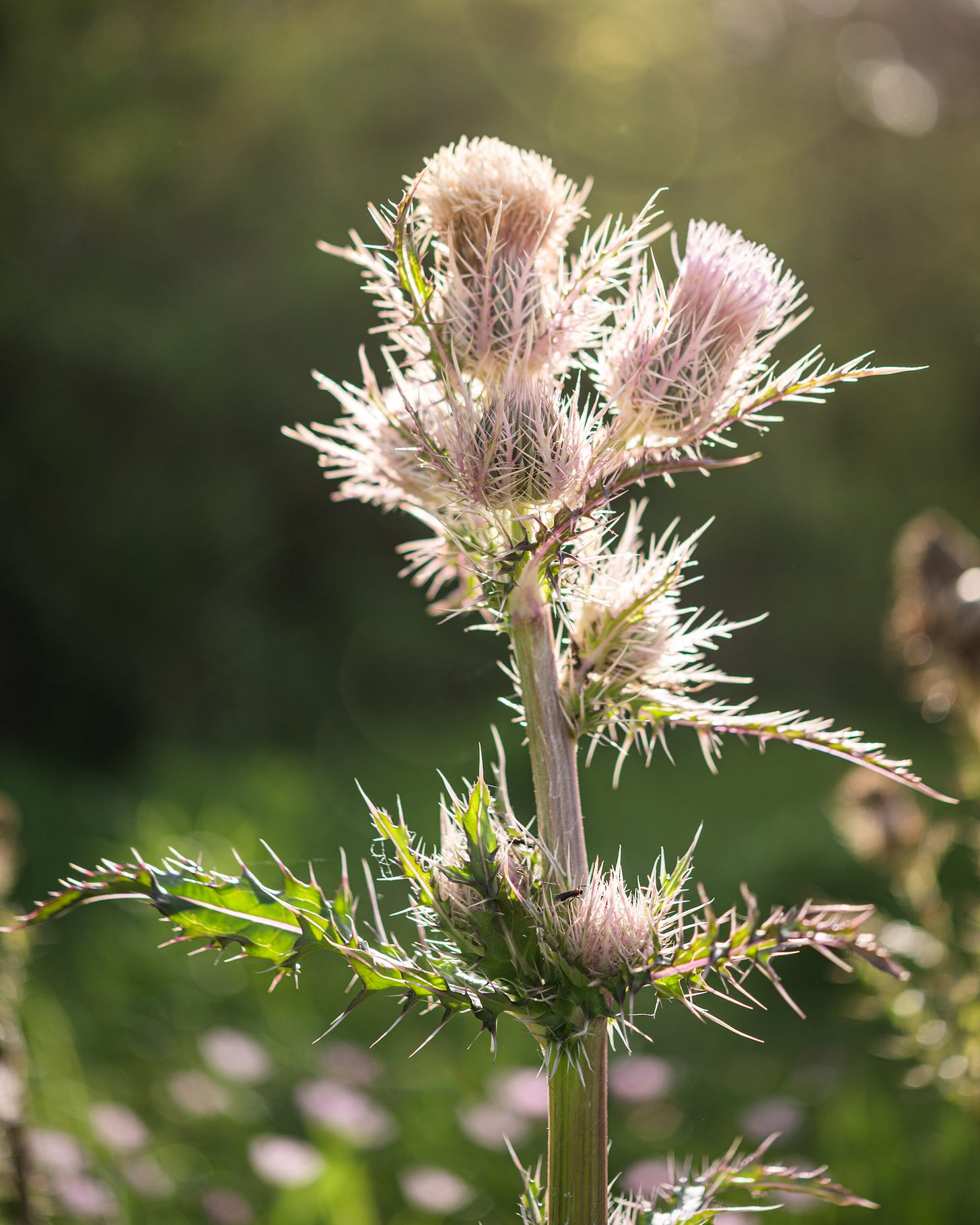Howdy folks,
Today’s newsletter is a little scattered—an accurate reflection of the inside of my head, perhaps. We’re starting with a story about a weed—ahem, thistle—known broadly as cirsium in Latin, and to Acadians as chadron.
The story: When I was in third or fourth grade, a kid on the playground wielded a small stone, perfectly rounded at three points—kind of like a tiny, plump fidget spinner. I’m old enough to say that we didn’t have internet or smart phones back then, so an interesting rock was worth coveting. When asked where others might acquire such a remarkable (grey) stone, that kid told us that they’re formed under the base of a specific plant, pointing to a large thistle growing in an adjacent field.
I wondered about the validity of his claim for years, dreaming about what treasures might be found under the tall thistles I’d spot out the window on road trips, but I never got close enough to one to prove him right or wrong. If you’ve laid eyes on the plant, surely you understand why: It looks like it wants to hurt you. The leaves? Narrow and spiky. The stalk? Covered in bristly thorns. The flower? Guarded all around by tiny, sharp armor. Eventually, I just accepted that that’s not how plants or stones work, and concluded that field research was not actually necessary.
Then, sometime last spring, a TikTok video from a local hip-hop artist Nate the Voice popped up on my #fyp. In the short clip, Nate shows that same thistle specimen, and asks, “Ya ever seen anybody eat one of these?” Then the video cuts to him taking a crisp bite out of the stalk. He posted a follow-up a few days later to demonstrate how he harvests the plant. That all happened around the time we were all going into lock-down, so I had forgotten about all of this until a recent trip out to Docville Farm in Meraux, where my buddy Blaise walked me through an orchard of various fruit trees he had just planted. I asked about what I thought was an artichoke growing wild in the adjacent field, but Blaise informed me that the plant was a young purple thistle and confirmed that the stalk would be edible once it grew out a bit more. He told me that the flavor and texture are similar to celery, and even posited a theory that many South Louisiana recipes that now call for celery may have originally used thistle—known locally as chadron, and considered by some to be a delicacy.
Why this type of information keeps swimming around my head, I couldn’t tell you. Maybe it’s because I’m losing a battle with the weed-turned-tree in my backyard. Maybe it’s because I grew up disconnected from so much of the land around me, and I’m trying to make up for that. Maybe—and most likely—I’m just procrastinating. Whatever the reason, though, I set out on a quest to harvest thistle; to taste it for myself, and to explore its potential in the kitchen.
I checked back in with Blaise before heading out on Monday, and he told me that it’s a little late in the season—that you want to find plants that aren’t yet knee-high and haven’t flowered—but I still had to try. I harvested several specimens, but most had turned fibrous and bitter, and all were very…hostile. According to the internet (which, okay, maybe I put too much trust in), most of the plant is edible: the stalk, the leaves, the buds of the flowers, the roots. How someone initially came to the conclusion that the reward would be worth the effort is beyond me.
Dear readers: I failed. I really wanted to test and share a recipe for chadron pickles, or for thistle with shaved parm and lots of black pepper, but I waited too long to harvest, and now all I’ve got to offer are the thorns still buried in my fingers.
I did manage to glean a few tender bites of stalk and the stems of some leaves, and those were pleasant—a similar texture to celery, but with a saltier and nuttier flavor. In my internet searches, I found several blog posts and dated articles about the nostalgia of foraging for thistle, and eventually stumbled upon this lone recipe from John Folse for chadron salad—if harvesting them is a chore, then prepping them for salad should come with a salary and benefits. First, the recipe instructs us to remove the thorns. Then, to cut the stalk into pieces. Then to soak those in salted water “until all debris and insects are removed.” Then to drain, then to pat dry, and then to skin them so they can be cut even smaller for the salad. Y’all hungry yet?
I failed this year, but I’m stubborn (and curious) enough to say I’ll try again next season. In the meantime, hit me up with any of your own chadron recipes or memories. And please, someone, bring me a pair of tweezers.
Blessing of the Fleet
Chauvin held their Blessing of the Fleet last Saturday, following the Fishermen’s Mass at St. Joseph Catholic Church. Lead by the Tiffani Claire, dozens of decorated boats navigated the six-mile route down Bayou Petit Caillou to Lake Boudreaux, while community members watched and waved from the banks.
The Blessing of the Fleet is an annual ceremony for several of South Louisiana’s coastal towns. Local clergy lead a parade down the bayou, blessing each boat they pass with holy water and symbolically kicking off the start to shrimp season. Many of the events were canceled last year due to COVID, but are returning this season—Lafitte’s blessing will be held this coming Saturday, and Dulac’s will be held on Sunday.
Food for Festing in Place
Friends have asked about Jazz Fest food vendors popping up again for Festing in Place, and while I don’t have many details, WWOZ does. They’ve published a list of how you can get ahold of most of your favorites. Jazz Fest is scheduled to return this fall, from October 8-17.
Smoked Fish & Creole Cream Cheese
To make up for my failures with the thistle, I offer this recipe for a smoked fish dip. It’s based on a trout dip from Alison Roman published by Bon Appétit back in 2015, but with Creole cream cheese in place of crème fraîche and with four times the lemon (and a little sumac) to cut through the dairy. I’ve tried it with a variety of smoked fish—speckled trout, redfish, blue catfish—and while trout and catfish give it a more delicate texture, redfish holds smoke really well, and I like the firmer bite.
Ingredients:
12 ounces smoked fish, pulled from the bones and flaked into small pieces
1/3 cup full fat Greek yogurt
1/4 cup Creole cream cheese
4 Tbsps. lemon juice
1/2 tsp. sumac
3 Tbsps. finely chopped chives or green onion
2 Tbsps. finely chopped dill
Kosher salt
Freshly ground pepper
Extra virgin olive oil for serving
Assembly:
In a large bowl, combine the fish, yogurt, Creole cream cheese, lemon juice, sumac, chives, and dill. Use a fork to mix everything together, breaking up larger pieces of the fish. Season with salt and pepper, and additional lemon juice, to taste.
Serve with a drizzle of olive oil on toast, crackers, or a large spoon straight from the bowl. (Rémy’s been eating the latest batch on toast with capers, and sprouts from our River Queen Greens CSA share.)
Lagniappe
Move over Metairie: New Orleans is getting three new Chik-fil-A restaurants. Eater has a collection of responses to the announcement.
In local sandwich news: Bub’s Burgers is opening up a brick and mortar restaurant.
So is Fritai, a Haitian restaurant led by Charly Pierre.
And Budsi’s Authentic Thai, another pop-up-turned-brick-and-mortar, has expanded hours to include lunch service.
Food & Wine just published their list of the “40 Most Important Restaurants of the Past 40 Years,” and to no one’s surprise, NOLA takes up several spots. Congrats to Commander’s Palace, Dooky Chase, Emeril’s New Orleans Fish House, and Compère Lapin.
Pitmaster James Cruse of Central City BBQ is in Brooklyn today, competing for the title of Brisket King.
Grow Dat Youth Farm is hosting a crawfish picnic on Bayou St. John on May 9.
Over on TikTok, @CouyonJosh is helping a crawfish cross the road.
RIP Brewster, the brewery rooster at Port Orleans.
Lastly, tragic news from the Gulf: Hurricane-force winds hammered the coast last week, capsizing a 175-foot power lift boat just eight miles out from Port Fourchon. Several crew members were killed, and eight remain missing.
Thanks, Y’all
Thank you for subscribing. Our next issue will kick off a new series of profiles focused on food businesses that have opened during—and for some, because of—the pandemic.











